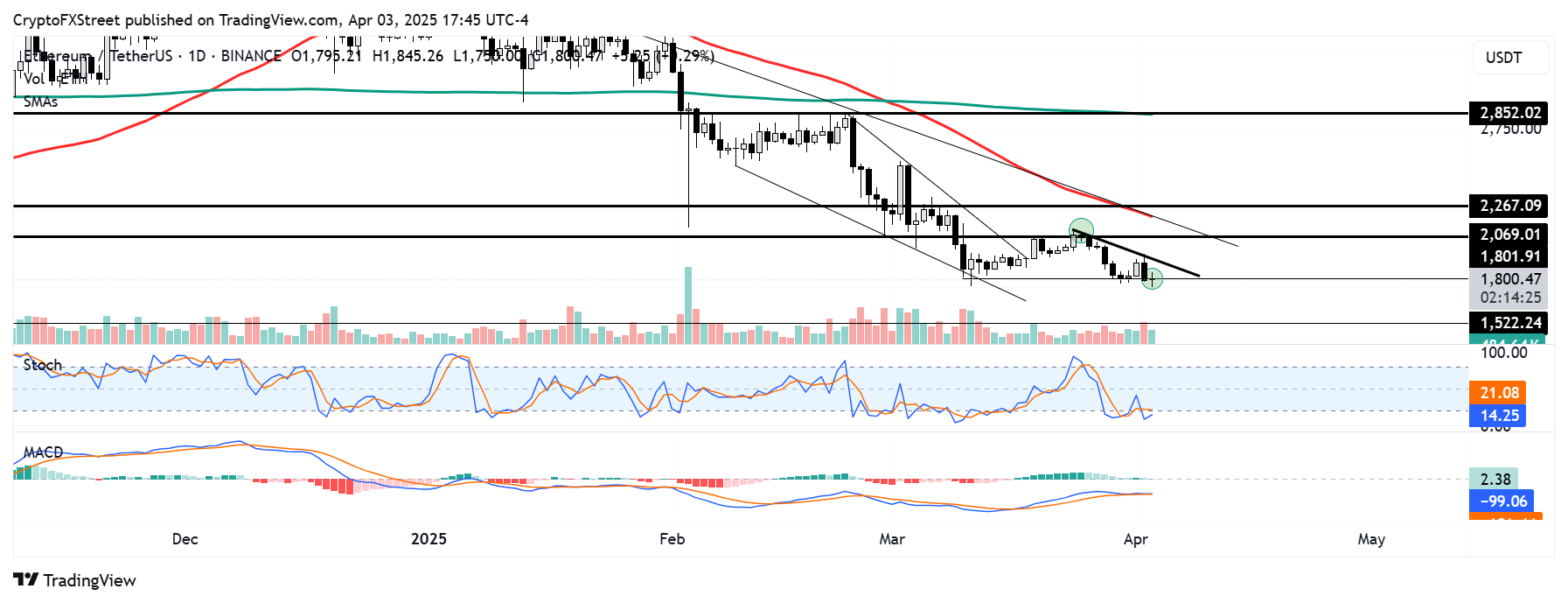Current Ethereum Price: $1,800
- The selling pressure from short-term Ethereum holders may ease in the upcoming weeks following their reduction of holdings in March.
- Developers have agreed to launch the Pectra upgrade on the mainnet on May 7.
- If the tested support at $1,800 fails, ETH might drop to $1,500.
Ethereum (ETH) experienced a 3% decline on Thursday as market participants continued to respond to recent announcements regarding reciprocal tariffs made by President Trump. However, the downward pressure may wane since most short-term holders (STHs) have already liquidated their positions in March.
Impact of Short-term Holders on Price and Pectra Upgrade Scheduled for May 7
Following Trump’s “Liberation Day” announcements regarding tariffs, data indicates that Ethereum whales sold off 380K ETH, contributing to the price decline over the past 24 hours.
Despite the downturn, the dormant circulation metric, which gauges the total number of coins moved daily since their last transaction, reveals that most investors remained inactive throughout this announcement period. The downward trend in this metric over the last couple of days suggests that investors from various categories were not active sellers in light of the tariff news.
ETH dormant circulation
The surges observed in March—primarily resulting from activities of short-term holders—indicate that this group has already reduced their positions in anticipation of tariffs. Given that STHs are more likely to sell during periods of market uncertainty, their diminished presence may lessen the downward pressure on ETH.
In addition, Ethereum’s latest All Core Developers Consensus (ACDC) meeting has confirmed the Pectra mainnet upgrade date as May 7. A successful upgrade could shift market sentiment towards ETH in a more favorable direction.
Pectra will bring a range of features to Ethereum, such as wallet recovery, transaction batching, sponsored transactions, an increased staking limit of 2,048 ETH, and expanded blobspace.
Ethereum Price Outlook: ETH Faces Further Decline Risks if $1,800 is Broken
Ethereum has declined over 3%, resulting in $47.7 million in liquidations of futures contracts over the last 24 hours, according to data. The total amount liquidated from long and short positions accounted for $34.52 million and $13.18 million, respectively.
ETH is currently testing the $1,800 support level following a rejection at the $2,070 resistance level last week. Should the price continue to fall, ETH may seek support at the $1,500 level in the near term. If bearish momentum remains strong, there’s a risk of a significant drop down to $1,000, a low not seen since the UST/LUNA crash in 2022.
ETH/USDT daily chart
The Stochastic Oscillator is currently in the oversold range, and the Moving Average Convergence Divergence (MACD) histogram bars are approaching a bearish flip, indicating prevailing downward momentum.
A solid rebound at the $1,800 support level would counter this bearish outlook and could allow ETH to revisit the resistance at $2,070.
Ethereum FAQs
Ethereum is a decentralized, open-source blockchain that features smart contract functionality. Its native cryptocurrency, Ether (ETH), ranks as the second-largest cryptocurrency and the leading altcoin by market capitalization. The Ethereum network is designed to facilitate the creation of various crypto applications such as decentralized finance (DeFi), GameFi, non-fungible tokens (NFTs), and decentralized autonomous organizations (DAOs).
Ethereum operates as a public decentralized blockchain, allowing developers to create and deploy applications that function without reliance on a central authority. To streamline this process, the network utilizes the Solidity programming language and the Ethereum virtual machine, aiding developers in building and launching smart contract-based applications.
Smart contracts are publicly verifiable codes that automate agreements between two or more parties. These codes execute predetermined actions automatically once specific conditions are fulfilled.
Staking involves earning yield on your inactive crypto assets by locking them into a protocol for a set duration, contributing to its security. Ethereum shifted from a Proof-of-Work (PoW) to a Proof-of-Stake (PoS) consensus mechanism on September 15, 2022, in an event dubbed “The Merge.” The Merge was a crucial milestone in Ethereum’s strategy to achieve heightened scalability, decentralization, security, and sustainability. In contrast to PoW, which necessitates costly hardware, PoS diminishes the entry barriers for validators by using crypto tokens as the foundation of its consensus approach.
Gas refers to the unit of measurement for transaction fees incurred by users for executing transactions on Ethereum. When the network experiences congestion, gas fees can surge dramatically, compelling validators to prioritize transactions according to their fees.

